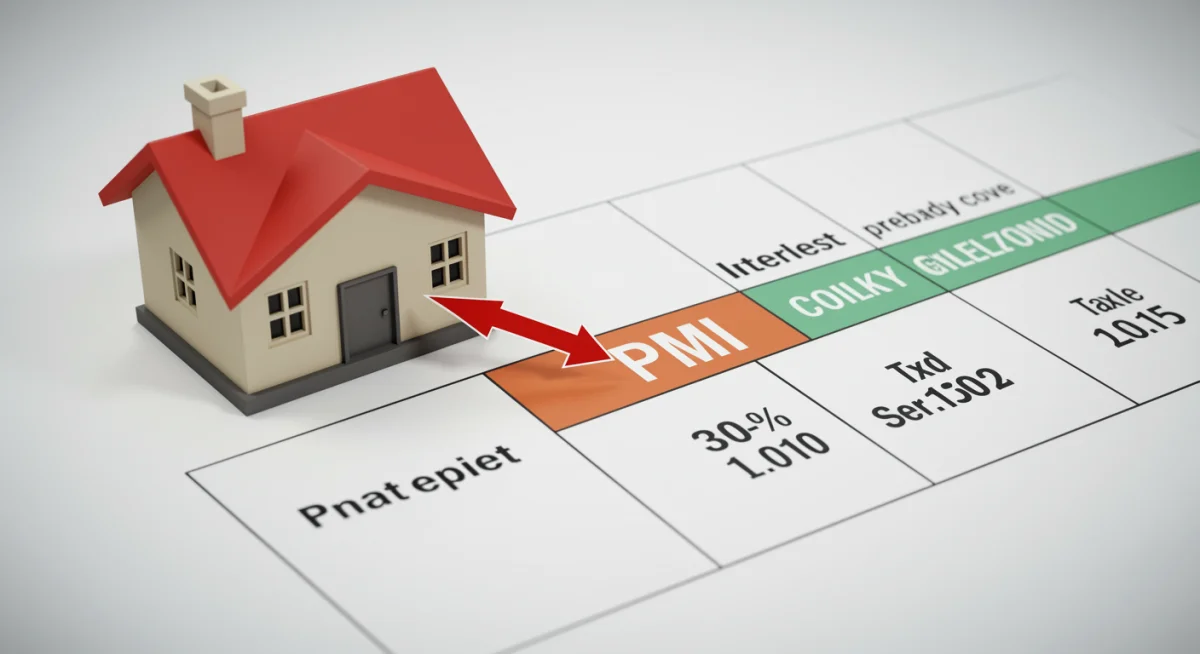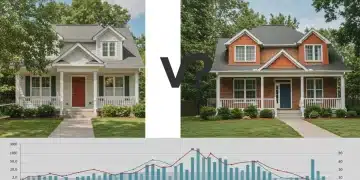PMI 2025: Strategies to Avoid or Remove Private Mortgage Insurance

As of early 2025, understanding strategies to avoid or remove Private Mortgage Insurance (PMI) remains crucial for homebuyers making less than a 20% down payment, directly impacting monthly housing costs and long-term financial planning.
For many aspiring homeowners in 2025, the dream of homeownership often comes with an added cost: Private Mortgage Insurance, or PMI 2025: Strategies to Avoid or Remove It When Putting Less Than 20% Down. This insurance protects lenders, not borrowers, when a down payment is less than 20% of the home’s purchase price. Understanding how to navigate or eliminate PMI is more critical than ever as housing markets evolve and interest rates fluctuate.
Understanding Private Mortgage Insurance (PMI) in 2025
Private Mortgage Insurance (PMI) continues to be a significant factor for homebuyers in 2025, particularly those unable to make a substantial down payment. This insurance acts as a safeguard for lenders against default, allowing them to approve loans with lower down payments, typically below 20% of the home’s value. While it enables more people to achieve homeownership, it also adds to the monthly mortgage burden.
Recent economic shifts and housing market dynamics have kept PMI relevant for a broad segment of buyers. As reported by financial analysts this quarter, the average PMI premium can range from 0.3% to 1.5% of the original loan amount annually, translating into hundreds of dollars added to monthly payments. This makes strategies for avoidance or removal increasingly valuable for budget-conscious consumers.
How PMI is Calculated
- Loan-to-Value (LTV) Ratio: The higher your LTV (meaning a smaller down payment), the higher your PMI premium typically will be.
- Credit Score: Borrowers with excellent credit scores often qualify for lower PMI rates.
- Loan Term: Shorter loan terms can sometimes lead to different PMI calculations, though this is less common.
- Loan Type: Conventional loans are subject to PMI, unlike FHA loans which have Mortgage Insurance Premiums (MIP) with different rules.
Strategy 1: Making a Larger Down Payment
The most straightforward and effective method to avoid PMI in 2025 is to make a down payment of 20% or more. This immediately eliminates the need for PMI, saving homeowners a considerable amount over the life of their loan. While challenging for many, saving aggressively for a larger down payment can yield significant long-term financial benefits.
Financial advisors across the board continue to emphasize the importance of this strategy. According to a recent report by the National Association of Realtors, first-time homebuyers often struggle to reach the 20% threshold, but those who do experience immediate savings and increased equity. This approach not only sidesteps PMI but also typically results in a lower monthly mortgage payment and less interest paid over time.
Consider exploring various savings vehicles and budgeting techniques to accumulate the necessary funds. Options like high-yield savings accounts, Certificates of Deposit (CDs), or even Roth IRA backdoor contributions (if eligible) can help accelerate savings. It’s about prioritizing and planning meticulously, often years in advance, to reach that 20% mark.
Strategy 2: Utilizing a Piggyback Loan (80/10/10 or 80/15/5)
For those unable to reach a 20% down payment, a piggyback loan, often structured as an 80/10/10 or 80/15/5 loan, presents a viable alternative to avoid PMI. This strategy involves taking out two loans simultaneously: a primary mortgage for 80% of the home’s value, and a second mortgage (often a home equity line of credit or HELOC) for a portion of the remaining balance, with the rest as a down payment.
For example, an 80/10/10 loan means a primary mortgage for 80% of the home’s value, a second loan for 10%, and a 10% down payment from the buyer. This way, the primary loan’s loan-to-value (LTV) ratio remains at 80%, bypassing PMI requirements. While this avoids PMI, it’s crucial to understand that the second loan will have its own interest rate, which can sometimes be higher than the first mortgage.

As of early 2025, the availability and terms of piggyback loans can vary based on market conditions and lender policies. It’s essential to compare the interest rates and fees of the second loan against the potential cost of PMI. Sometimes, the combined cost might be similar, but piggyback loans offer the advantage of having a fixed payment or a more predictable payment schedule compared to the variable nature of PMI removal processes.
Strategy 3: Lender-Paid Mortgage Insurance (LPMI)
Lender-Paid Mortgage Insurance (LPMI) is another option for homebuyers looking to avoid direct PMI payments. With LPMI, the lender pays for the mortgage insurance, but in exchange, the borrower typically accepts a slightly higher interest rate on their loan. This effectively rolls the cost of PMI into the interest rate, making it a tax-deductible expense for some, unlike traditional PMI which is often not.
Key Considerations for LPMI
- Higher Interest Rate: Your monthly mortgage payment will be higher due to the increased interest rate, but you won’t see a separate PMI line item.
- Non-Removable: Unlike borrower-paid PMI, LPMI cannot be canceled once your home equity reaches 20%. The higher interest rate remains for the life of the loan or until refinancing.
- Tax Deductibility: The increased interest paid due to LPMI may be tax-deductible, offering a potential financial advantage.
- Long-Term Cost: Evaluate whether the higher interest rate over the life of the loan will cost more than traditional PMI that can be canceled.
Industry experts suggest that LPMI can be a good option for borrowers who plan to stay in their home for a shorter period or who can benefit significantly from the tax deduction. However, for those planning to stay long-term, the higher interest rate over decades could outweigh the initial benefit of avoiding PMI. Always consult with a financial advisor to assess if LPMI aligns with your overall financial goals in 2025.
Strategy 4: Refinancing to Remove PMI
For homeowners who currently pay PMI, refinancing their mortgage can be an effective strategy to eliminate these payments. This typically involves securing a new loan once your home equity reaches 20% or more of its appraised value. As of early 2025, with fluctuating interest rates, timing is crucial for this strategy to be financially advantageous.
Refinancing allows you to replace your existing mortgage with a new one that has a lower loan-to-value (LTV) ratio, thus removing the PMI requirement. Before initiating a refinance, it’s essential to have your home appraised to confirm its current market value. Lenders will use this appraisal to determine your new LTV. If the home value has appreciated significantly since your purchase, you might reach the 20% equity threshold sooner than expected.
However, refinancing comes with its own set of costs, including closing fees and appraisal charges. It’s vital to calculate if the savings from eliminating PMI outweigh these upfront expenses. Current market trends indicate that while some homeowners are finding favorable refinance rates, others are waiting for more stable conditions. Always shop around for the best refinance terms and compare them against your current mortgage and PMI payments.
Strategy 5: Requesting PMI Cancellation
Homeowners paying PMI on a conventional loan have the right to request its cancellation once their loan-to-value (LTV) ratio reaches 80% of the home’s original appraised value or purchase price, whichever is less. This process is typically initiated by the homeowner and requires a formal request to the mortgage servicer. This strategy is distinct from automatic termination and puts the onus on the borrower to act.
To request cancellation, you generally need to demonstrate that your home equity has reached the 20% threshold. This often involves providing proof of your home’s current market value through a new appraisal, which you will likely pay for. Additionally, lenders usually require a good payment history, meaning no late payments within a specified period (e.g., 12-24 months), and no subordinate liens on the property.
It’s crucial to track your home’s value and your loan balance regularly. Many lenders provide online tools or statements that show your current equity. Keep in mind that even if your home’s value has increased significantly, the 80% LTV is often calculated based on the original purchase price or appraised value, not the current market value, unless you’re requesting cancellation based on property improvements. Always review your loan documents for specific cancellation criteria, as rules can vary slightly by lender and loan type.
Strategy 6: Automatic PMI Termination
Beyond requesting cancellation, federal law, specifically the Homeowners Protection Act (HPA) of 1998, mandates that PMI must automatically terminate for most conventional loans once certain equity thresholds are met. This provides a safety net for homeowners who might not actively monitor their equity or forget to request cancellation. Understanding these automatic termination rules is crucial for all borrowers with PMI.
Automatic Termination Rules
- 78% LTV: PMI must automatically terminate when your loan-to-value (LTV) ratio reaches 78% of the original value of your home, based on the initial amortization schedule. This occurs even if you haven’t requested it.
- Midpoint of Loan: PMI also automatically terminates at the midpoint of your loan’s amortization period, regardless of your LTV, provided you are current on your payments. For a 30-year loan, this would typically be after 15 years.
- Good Payment History: To qualify for automatic termination, you must be current on your mortgage payments. Any delinquencies can delay the termination process.
It’s important to note that these rules apply to conventional loans originated after July 29, 1999. If your loan was taken out before this date, or if it’s an FHA loan (which has different mortgage insurance premium rules), these automatic termination provisions may not apply. Homeowners should receive an annual disclosure from their mortgage servicer outlining their PMI rights and estimated termination dates. If you believe you qualify for automatic termination but it hasn’t occurred, contact your servicer immediately.
| Key Strategy | Brief Description |
|---|---|
| Larger Down Payment | Paying 20% or more upfront to avoid PMI entirely. |
| Piggyback Loan | Using a second mortgage to keep the primary loan at 80% LTV. |
| Refinance | Obtaining a new mortgage when equity reaches 20% to eliminate PMI. |
| PMI Cancellation | Requesting termination once 20% equity is achieved and requirements are met. |
Frequently Asked Questions About PMI in 2025
PMI is an insurance policy that protects mortgage lenders if a borrower defaults on their loan. It’s typically required when a homebuyer makes a down payment of less than 20% of the home’s purchase price, mitigating the lender’s risk.
Historically, PMI premiums have been tax-deductible under certain conditions. However, the deductibility of mortgage insurance premiums can vary year to year based on tax law changes. Consult a tax professional for the most current information regarding 2025.
A piggyback loan allows you to take out a primary mortgage for 80% of the home’s value and a second loan for a portion of the down payment. This keeps the primary loan’s loan-to-value (LTV) at 80%, thus eliminating the need for PMI.
Requesting cancellation means you actively ask your lender to remove PMI once you reach 20% equity. Automatic termination is mandated by federal law when your equity reaches 78% of the original value, or at the loan’s midpoint, provided payments are current.
FHA loans have their own form of mortgage insurance called Mortgage Insurance Premiums (MIP), which has different rules than conventional loan PMI. MIP often lasts for the life of the loan, regardless of equity, unless refinanced into a conventional loan.
What Happens Next
As 2025 progresses, the landscape for Private Mortgage Insurance (PMI) will continue to be influenced by housing market trends, interest rate policies, and lender guidelines. Homeowners and prospective buyers should remain vigilant, regularly assessing their equity position and exploring new financial products. Ongoing developments from regulatory bodies and shifts in property values will dictate the most advantageous strategies for managing or eliminating PMI, directly impacting affordability and long-term financial planning for millions. Staying informed and consulting with financial professionals will be key.





